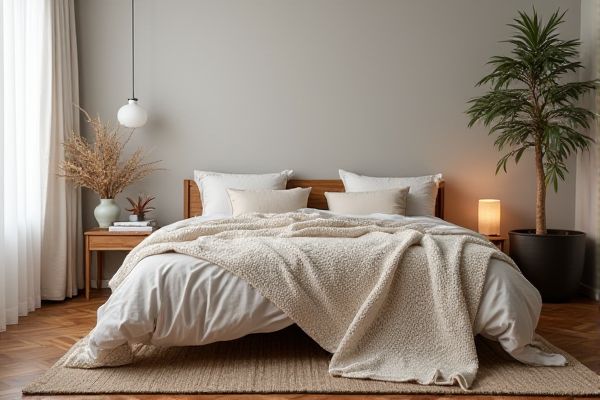
A throw blanket is a lightweight, versatile piece often used for added warmth and decoration on couches or chairs, while a quilt is a thicker, stitched bed covering designed for warmth and durability. To understand which option best suits Your comfort and style needs, continue reading the rest of the article.
Table of Comparison
| Feature | Throw Blanket | Quilt |
|---|---|---|
| Purpose | Provides warmth and decoration, often used on sofas or chairs. | Used as bedding for warmth, layering, and decorative purposes on beds. |
| Material | Typically fleece, wool, or synthetic fibers. | Usually cotton with quilted fabric layers and batting inside. |
| Size | Smaller, usually 50" x 60" or similar. | Larger, ranges from twin to king bedding sizes. |
| Weight | Lightweight and easy to carry. | Heavier due to multiple layers and stitching. |
| Design | Varies widely; often casual and colorful. | Often features intricate stitching, patterns, and traditional designs. |
| Care | Machine washable and low maintenance. | Requires gentle washing; some are hand washable or dry clean only. |
| Use Cases | Snuggling on a couch, outdoor use, decorative throw. | Bed covering, layered bedding, heirloom or collectible item. |
Introduction: Throw Blanket vs Quilt
Throw blankets and quilts serve different purposes in home decor and comfort. A throw blanket is typically lightweight, smaller, and designed for casual use or accenting furniture, while quilts are heavier, often handmade, and focus on warmth with layered fabric stitched together. Choosing between a throw blanket and a quilt depends on your need for style, warmth, and functionality in your living space.
Defining Throw Blankets and Quilts
Throw blankets are lightweight, versatile fabric pieces typically used for added warmth and decorative purposes on sofas or chairs, often measuring around 50 by 60 inches. Quilts consist of three layers--top fabric, batting, and backing--stitched together in intricate patterns, providing both insulation and aesthetic value, commonly sized for beds. While throw blankets emphasize portability and casual use, quilts are traditionally crafted for durability and layering in bedding.
Key Material Differences
Throw blankets typically feature soft, plush fabrics like fleece, microfiber, or cashmere, providing lightweight warmth and cozy comfort. Quilts are constructed with layers of fabric and batting, often cotton or polyester, stitched in intricate patterns to offer durability and added insulation. Understanding these key material differences helps you choose the ideal option based on warmth, texture, and aesthetic preferences.
Warmth and Insulation Comparison
Throw blankets made from materials like fleece or wool provide lightweight warmth ideal for casual use, while quilts, often filled with down or synthetic batting, offer superior insulation by trapping heat more effectively. Quilts feature layered construction that maximizes heat retention, making them better suited for colder environments or extended overnight use. The thermal efficiency of quilts generally surpasses that of throw blankets, which are designed for portability and aesthetic appeal rather than maximum warmth.
Style and Aesthetic Appeal
Throw blankets offer a versatile and cozy accent with a variety of textures, colors, and patterns that enhance the visual warmth of living spaces. Quilts showcase intricate stitching and classic patchwork designs, adding a timeless, handcrafted charm to bedrooms or seating areas. Both options elevate room decor, but throws tend to complement modern, casual styles while quilts emphasize traditional and rustic aesthetics.
Practical Uses and Versatility
Throw blankets offer lightweight warmth and are highly portable, making them ideal for layering on couches or easily carried for outdoor use. Quilts provide a thicker, more structured covering typically used as bedspreads or for added insulation during colder nights. Your choice depends on whether you need a versatile, casual wrap or a durable, decorative bedding option.
Maintenance and Care Requirements
Throw blankets typically require simple maintenance, often being machine washable and quick to dry, making them convenient for everyday use. Quilts, especially those with intricate stitching or vintage fabrics, need more delicate care such as gentle washing, air drying, or professional cleaning to preserve their structure and color. Proper care for both items ensures longevity, with throws favoring practicality and quilts demanding careful handling due to their craftsmanship and materials.
Price Range and Affordability
Throw blankets typically range from $20 to $100, offering affordable options for budget-conscious shoppers, while quilts generally start around $50 and can exceed $200 depending on craftsmanship and materials. The simpler construction and bulk production of throw blankets contribute to their lower price points compared to quilts, which often involve intricate stitching and higher-quality fabrics. Budget considerations favor throw blankets for casual use, whereas quilts may appeal to those seeking durable and decorative bedding with a higher investment.
Ideal Settings for Throws and Quilts
Throw blankets are ideal for casual settings such as living rooms, lounges, or outdoor patios where you need lightweight warmth and easy portability. Quilts are better suited for bedrooms and colder environments, offering more substantial insulation and decorative appeal over beds. Your choice depends on whether you need cozy layering for relaxation or durable warmth for nighttime comfort.
Choosing the Right Option for Your Home
Throw blankets provide lightweight warmth and decorative versatility, ideal for layering on sofas or beds to complement existing decor. Quilts offer thicker, more structured insulation with traditional stitching patterns, making them suitable for both bedding and cozy lounging. Selecting the right option depends on your desired comfort level, aesthetic preference, and the primary use--whether for warmth, decoration, or both.
 homyna.com
homyna.com